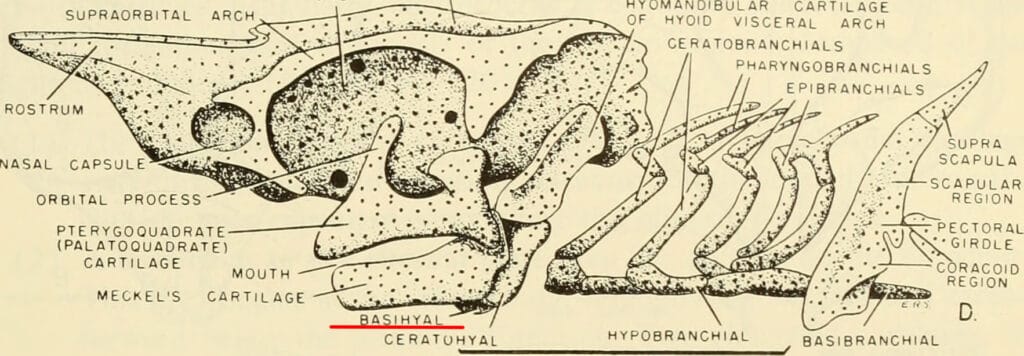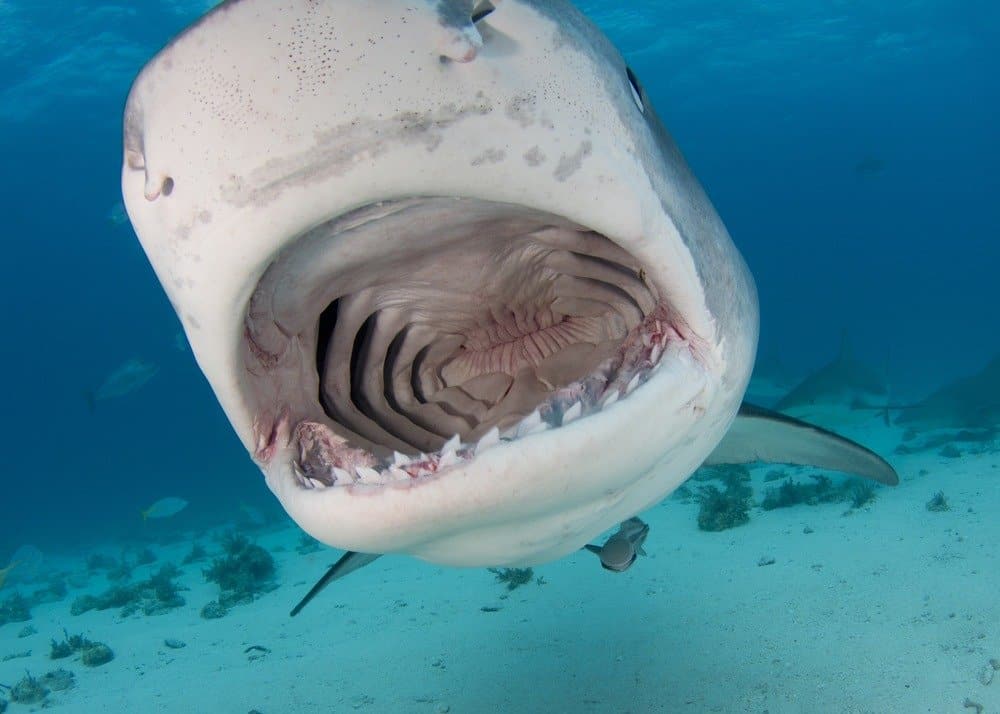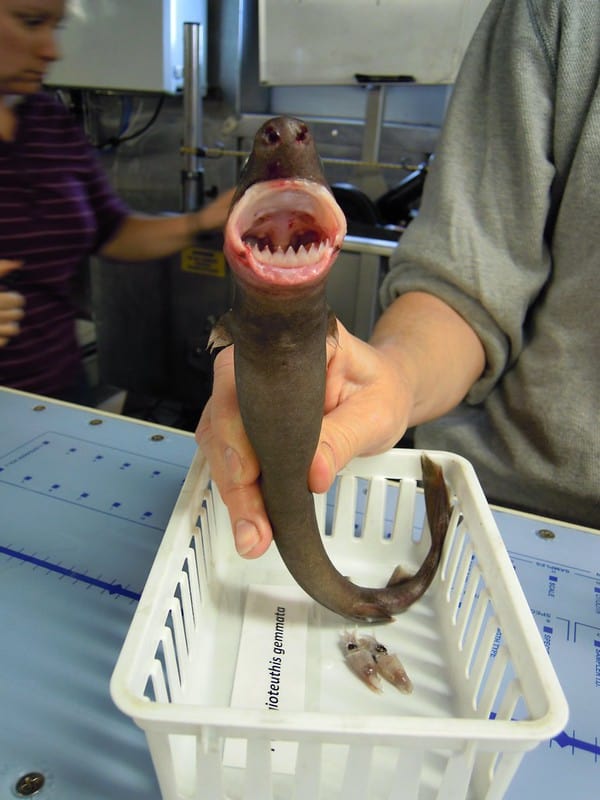Our ocean is home to around 500 shark species. As a result, you may expect to observe a variety of sharks of various shapes and sizes. Hollywood has been on a shark rampage for as long as we can remember, where sharks are always depicted as animals with extreme blood sensitivity. Their massive teeth, violent temperament, and ability to destroy anything that gets in their way with a simple whim made them the salty sea’s villains. That’s about all anyone knows about sharks. But, out of curiosity, you could wonder, “Wait, do sharks have tongues?”
A human tongue is a multi-purpose organ that allows humans to taste food, move food around in the mouth, be flexible, and speak, among other things. Many researchers believe that a shark’s tongue is a short, fat, and inflexible organ that provides no actual benefit to the shark. The tongue does not even have any taste buds. Like humans and other animals, sharks have tongues, but theirs do not serve the same purpose as ours. This article will explore the truth about the shark’s tongue, its purpose, and other fascinating facts.
Do Sharks Have Tongues?

A shark’s tongue is called a basihyal.
©Internet Archive Book Images / flickr – License
Yes, sharks have a tongue, and it is referred to as a “basihyal” rather than a tongue. A shark’s tongue cannot move in the same way that a human tongue can since it is not a muscle. The bottom of a shark’s mouth contains this little thick chunk of cartilage, and it doesn’t have any taste buds or perform any functions. Hence, when sharks open their mouths, all we notice are their fearsome teeth, which dominate all other shark characteristics.
According to experts, a shark’s tongue is designed to provide protection, and it protects the ventral aorta, an important part of a shark’s anatomy. The ventral aorta is protected against large pieces of food since it is so near to the shark’s mouth. The lower gill-related bones are supported by this bar-like structure that runs down the middle of the shark’s chest. The basihyal is relatively immovable and ineffective in most sharks. However, in some sharks, such as carpet sharks and bull sharks, the basihyal is bigger, flattened, and moveable, and it is utilized in conjunction with strong neck muscles to help suck up prey.
These muscular structures also drive water back into the shark’s oral cavity when it eats live food. It helps remove debris from the teeth and gills, providing necessary oxygen as part of the respiration process.
Can a Shark Stick Out its Tongue?

Sharks can not stick out their tongues.
©iStock.com/Jtafalla
No, sharks can not stick out their tongues.
A sharks’ tongue is attached to the mouth’s floor. Because cartilage is the major component, it has little flexibility, preventing sharks from sticking out their tongues. You might be curious about the answer because you’ve seen orcas sticking their tongues out in photos, movies, or even in person. So, why are sharks unable to do the same? Shark tongues are constructed of cartilage, unlike human or other animal tongues, so muscle mobility is restricted. As a result, sharks cannot stretch the cartilage and push it out of their mouth.
Ordinary sharks, unlike other animals, also do not require their tongues to grab their prey—at least not all of them. The tongues of sharks are attached to the bottom of their jaws. Electroreceptors are one of the ways they catch prey. As a result, they lack the length and location of their tongues to be inventive when hunting. To suck in their food, they only need to create a vacuum.
Do Sharks Taste?

A shark’s taste bud is not sensitive, and it merely tells them whether a food is edible or safe to eat.
©Matt9122/Shutterstock.com
Sharks’ tongues are devoid of taste buds, but this doesn’t mean that sharks don’t enjoy eating. Instead, the papilla lining in their mouth and throat is responsible for tasting. However, this taste bud is not sensitive, and it merely tells them whether a food is edible or safe to eat. Sharks have a poor sense of taste, even with the lining taking over the job of tasting. They take an initial bite and spit out any prey that doesn’t taste like food. When the shark’s typical diet gets scarce when hunting, they lose all sense of judgment and eat whatever they see fit.
Sharks may lack taste buds, but they do have electroreceptors around their snout called ampullae of Lorenzini, which they employ to catch prey. This also helps identify electric fields emitted by small fish in murky water.
Not all sharks have latent tongues, and three shark species have active basihyals out of over 500 shark species. In addition to carpet and bull sharks, the cookie-cutter sharks are the ones you should watch out for.
What is the Purpose of a Cookie-Cutter Shark’s Tongue?

The tongues of cookie-cutter sharks are attached to their throats.
©NOAA Photo LibraryFollow / flickr – License
Cookie-cutter sharks use their tongues to consume their prey. These sharks have much stronger tongues than other sharks. The rectus cervicis, which are very powerful throat muscles, connect and strengthen them. Unlike other animals, their tongues are attached to their throats rather than the bottom of their mouths.
This allows these sharks to suck cookie-shaped meat from their victims (thus their names), consisting primarily of cetaceans, pelagic fishes, and pinnipeds. These sharks also have razor-sharp teeth that they utilize to break open their victims before sucking the meat out with their powerful neck muscles.
What Animal Has No Tongue?

Sea stars lack tongues.
©Vojce/Shutterstock.com
Eating time is the best time for humans and most animals! We taste the meal with our tongues, and if it tastes delicious, we are more likely to eat it again and again. Unfortunately, other species, such as sea stars, sea urchins, echinoderms, and crustaceans (such as crabs), do not have tongues.
Sea stars are omnivorous and feed in various ways, including swallowing whole prey items or putting their stomach out through their mouth and using it to take in prey without the use of their tongue.
Even though insects lack a tongue, they manage to get by just well without one. Butterflies and flies use their feet to taste food. Fruit flies have taste receptors all over their body, including on their wings and ovipositors, or egg-laying openings.
The photo featured at the top of this post is © Alessandro De Maddalena/Shutterstock.com
Thank you for reading! Have some feedback for us? Contact the AZ Animals editorial team.






